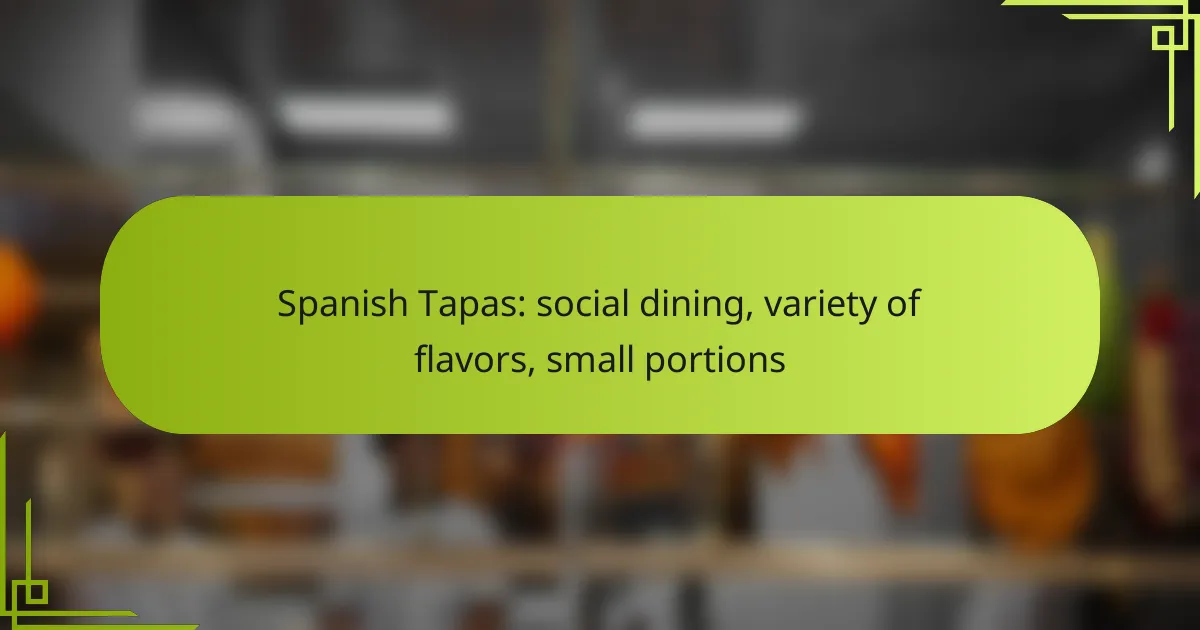Spanish tapas offer a delightful way to experience social dining through a variety of flavorful small dishes designed for sharing. These bite-sized portions encourage conversation and allow diners to sample an array of tastes, from savory seafood to rich cured meats. By incorporating diverse ingredients, tapas create an engaging atmosphere that caters to different palates and dietary preferences.

What are the best Spanish tapas for social dining in London?
The best Spanish tapas for social dining in London include a variety of flavorful small dishes that encourage sharing and conversation. Popular choices often feature ingredients like potatoes, seafood, and cured meats, allowing diners to experience a range of tastes in one meal.
Patatas Bravas
Patatas Bravas are a staple in Spanish tapas, consisting of crispy fried potatoes served with a spicy tomato sauce and aioli. This dish is perfect for sharing and offers a satisfying crunch paired with rich flavors. Many London tapas bars serve variations, so be sure to try different sauces for a unique experience.
Gambas al Ajillo
Gambas al Ajillo features succulent prawns sautéed in olive oil with garlic and a hint of chili. This dish is quick to prepare and is often enjoyed with crusty bread to soak up the flavorful oil. When ordering, look for fresh prawns to ensure the best taste and quality.
Chorizo al Vino
Chorizo al Vino consists of spicy Spanish sausage cooked in red wine, which enhances its robust flavor. This dish is typically served warm and is ideal for sharing among friends. Pair it with a glass of red wine to complement the dish’s richness.
Pan con Tomate
Pan con Tomate is a simple yet delicious dish made of toasted bread topped with ripe tomatoes, garlic, and olive oil. It’s a refreshing option that balances the heavier tapas and is often served as a starter. Look for high-quality bread and ripe tomatoes for the best flavor.
Albondigas
Albondigas are Spanish meatballs, usually made from a mix of beef and pork, seasoned with herbs and spices. They are often served in a rich tomato sauce, making them a hearty addition to any tapas spread. When ordering, consider trying different sauces or sides to enhance the dish’s flavor profile.

How to create a diverse tapas menu for a gathering?
To create a diverse tapas menu for a gathering, focus on offering a variety of small dishes that cater to different tastes and dietary preferences. Incorporating a mix of flavors, textures, and ingredients will enhance the social dining experience and keep guests engaged.
Incorporate vegetarian options
Including vegetarian options is essential for accommodating guests with dietary restrictions. Consider dishes like patatas bravas (spicy potatoes), grilled vegetables, or stuffed peppers. Aim for at least two to three vegetarian tapas to ensure everyone has choices.
Utilize ingredients such as olives, cheese, and legumes to create flavorful vegetarian options. These dishes can be just as satisfying and delicious as their meat counterparts, making them a hit at any gathering.
Balance flavors and textures
A well-rounded tapas menu should balance various flavors and textures to provide an enjoyable experience. Combine savory, sweet, and spicy elements, and mix crunchy, creamy, and soft dishes. For instance, pair a rich cheese with a tangy chutney or serve crispy calamari alongside a smooth aioli.
Consider using herbs and spices to enhance flavors without overwhelming the palate. This approach not only keeps the menu interesting but also encourages guests to try a little bit of everything.
Include regional specialties
Incorporating regional specialties can add authenticity and excitement to your tapas menu. Focus on dishes that reflect the culinary traditions of Spain, such as chorizo al vino (chorizo in wine) or gambas al ajillo (garlic shrimp). These items can spark conversations about their origins and preparation methods.
Research local Spanish markets or specialty stores for authentic ingredients to elevate your dishes. This attention to detail can impress your guests and create a memorable dining experience that celebrates Spanish culture.

What are the health benefits of sharing small portions?
Sharing small portions, like those found in Spanish tapas, can lead to several health benefits, including improved digestion and enhanced social interaction. By consuming smaller amounts, individuals can enjoy a variety of flavors while maintaining a balanced diet.
Promotes mindful eating
Sharing small portions encourages mindful eating, as it allows individuals to savor each bite and appreciate the flavors. When dining with others, the focus shifts to the experience rather than just the food, leading to greater awareness of hunger cues and fullness.
To practice mindful eating, take time to chew slowly and engage in conversation. This can help prevent overeating and foster a deeper connection with the meal and those sharing it.
Encourages variety in diet
Small portions naturally promote dietary variety, allowing diners to sample multiple dishes in one meal. This approach can lead to a more balanced intake of nutrients, as different foods provide various vitamins and minerals.
For example, a typical tapas spread might include olives, seafood, and vegetables, each contributing unique health benefits. Aim to try at least three to five different dishes to maximize nutritional diversity while enjoying the social aspect of dining.

How to pair drinks with Spanish tapas?
Pairing drinks with Spanish tapas enhances the dining experience by complementing the diverse flavors of the small portions. Consider the characteristics of both the tapas and the beverages to create a harmonious balance that elevates each bite.
Best wines for tapas
When selecting wines for tapas, opt for light and refreshing varieties that won’t overpower the dishes. Spanish whites like Albariño or Verdejo are excellent choices, as they offer crisp acidity and fruity notes that pair well with seafood and vegetable tapas.
For red wine, consider a young Tempranillo or Garnacha, which provide a fruity profile that complements meat-based tapas. A good rule of thumb is to match the wine’s body with the richness of the dish: lighter wines for lighter tapas and fuller-bodied wines for heartier options.
Cocktails that complement flavors
Cocktails can also enhance the flavors of tapas, especially those that are citrusy or herbal. A classic choice is the gin and tonic, which pairs well with a variety of tapas due to its refreshing nature and ability to cleanse the palate.
Another great option is a sangria, which combines red wine with fruits and spices, making it versatile for different tapas. For a more adventurous pairing, consider a vermouth-based cocktail, which can highlight the savory elements of dishes like olives and cheeses.

What are the essential ingredients for making tapas at home?
To create authentic tapas at home, focus on a few key ingredients that enhance flavor and authenticity. Essential components include high-quality olive oil, fresh garlic, and a variety of fresh herbs, which together form the backbone of many traditional tapas dishes.
Olive oil
Olive oil is fundamental in Spanish cuisine, especially for tapas. Use extra virgin olive oil for its rich flavor and health benefits. It can be drizzled over dishes, used for sautéing, or as a base for marinades.
When selecting olive oil, look for options labeled as “first cold press” to ensure quality. A good rule of thumb is to keep a bottle of both regular and flavored oils, such as garlic or chili-infused, to add variety to your dishes.
Garlic
Garlic is another essential ingredient that adds depth to tapas. Fresh garlic can be used in various forms, including minced, sliced, or roasted, depending on the dish. It pairs well with vegetables, meats, and seafood.
For optimal flavor, consider using whole cloves or roasting them to mellow their intensity. Avoid pre-minced garlic, as it often lacks the fresh taste and aroma that enhances your tapas experience.
Fresh herbs
Fresh herbs elevate the flavor profile of tapas, making them vibrant and aromatic. Common herbs used include parsley, cilantro, and thyme, each bringing its unique taste to the table. Incorporate them into dishes or use them as garnishes for a fresh finish.
To maximize flavor, chop herbs just before use and consider mixing different varieties for a more complex taste. Store fresh herbs in the refrigerator wrapped in a damp paper towel to keep them fresh longer.

How to host a successful tapas night?
To host a successful tapas night, focus on creating a relaxed atmosphere with a variety of small dishes that encourage sharing and conversation. Aim for a diverse selection of flavors and textures to cater to different tastes, ensuring everyone can find something they enjoy.
Set up a buffet-style layout
A buffet-style layout allows guests to serve themselves, promoting a casual and interactive dining experience. Arrange the tapas on a large table or counter, making sure to provide ample space for guests to move around comfortably.
Consider using decorative platters and bowls to showcase the variety of dishes. Label each item with its name and key ingredients to help guests make informed choices, especially if they have dietary restrictions.
To enhance the experience, include a mix of cold and warm dishes, such as patatas bravas, chorizo al vino, and marinated olives. This variety not only adds visual appeal but also caters to different preferences and appetites.










